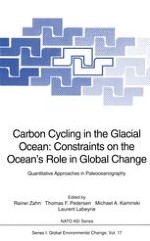1994 | OriginalPaper | Chapter
From Modern Flux to Paleoflux: Assessment from Sinking Assemblages to Thanatocoenosis
Author : Kozo Takahashi
Published in: Carbon Cycling in the Glacial Ocean: Constraints on the Ocean’s Role in Global Change
Publisher: Springer Berlin Heidelberg
Included in: Professional Book Archive
Activate our intelligent search to find suitable subject content or patents.
Select sections of text to find matching patents with Artificial Intelligence. powered by
Select sections of text to find additional relevant content using AI-assisted search. powered by
Particle fluxes using sediment traps have been seriously studied in the past decade for various microfossil groups including biogenic opal. We have accumulated a substantial amount of information pertinent to properly interpret the past environments. The majority of biogenic opal production is lost due to dissolution mainly at the sea-floor and only a minute fraction can be preserved in the fossil record. Numerical correlations between fluxes and the fossil record are needed to establish a linkage between modern and fossil assemblages based on the minute quantity preserved. A prototype numerical paleoecological method has been constructed. This method is used to quantitatively interpret paleofluxes of diatoms. Paleoflux results from two diatom taxa are presented from the northeastern Pacific: Denticulopsis seminae and Coscinodiscus marginatus. Denticulopsis seminae, a pennate diatom taxon widely occurring in the high latitude subarctic Pacific, is characterized as a productivity taxon in the pelagic realm with high fossil abundance. The other taxon important for winter conditions in the present day subarctic Pacific is Coscinodiscus marginatus, one of the best preserved diatoms in the fossil record of the region.
